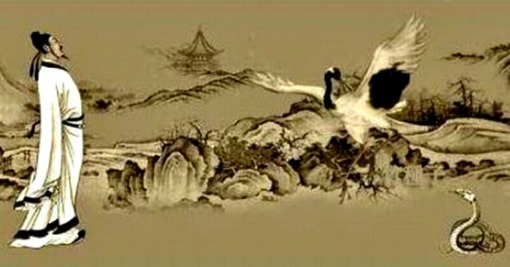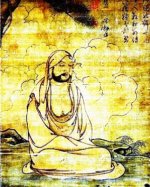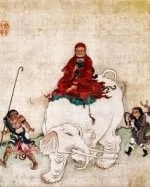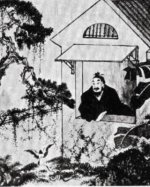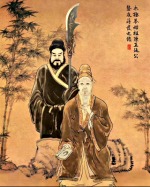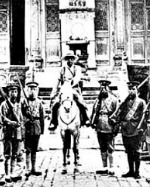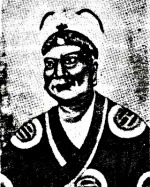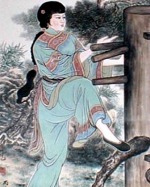Zhang Sanfeng - Legendary Founder of Tai Chi Chuan
Talk the Talk
Chi, also known as Qi is an integral part of the internal martial arts of China.
Not to be confused with the same word in Tai Chi
(which means Supreme), it is an energy force that flows through everything.
It can be enhanced with regular practice of certain movements, breathing exercises and meditations
that are found in Tai Chi Chuan and other internal arts.
Walk the Walk
While it is impossible to verify with the sources currently available if Zhang Sanfeng had any influence on the creation
of Tai Chi Chuan, it does seem likely that a Taoist monk of that name lived around the time of the Ming Dynasty and had an influence on the temples in the vicinity of the Wu
Tang Mountains.
As a Taoist, he would have had knowledge of the Three Treasures, Jing (the body's physical essence), Qi (life-energy/breath) and Shen (silent mental
focus) which are important concepts within modern Tai Chi.
It could also be said that as a wandering holy man, he would have had to have been skilled in the martial arts in order to defend himself on the roads, though whether or not he actually created a new style of fighting is questionable at best.
Kung Fu Quote
"What is essential to practice the Tao is to get rid of cravings and vexations. If these afflictions are not removed, it is impossible to attain
stability.
This is like the case of the fertile field, which cannot produce good crops as long as the weeds are not cleared away.
Cravings and ruminations are the weeds of the mind; if you do not clear them away, concentration and wisdom do not develop."
~ Attributed to Zhang Sanfeng ~
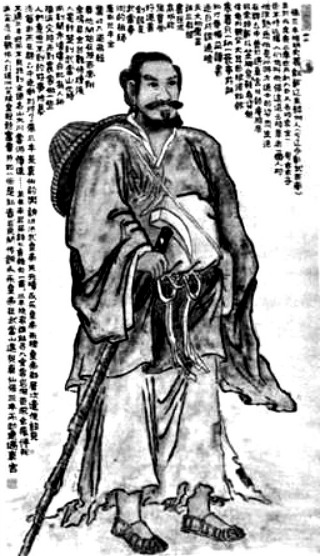 Zhang Sanfeng is a legendary Taoist monk who is believed by some to have invented a style of fighting called Mien Chuen (Cotton Fist) that would evolve into modern-day Tai Chi Chuan. While it is questionable whether he actually existed, the tradition of his influence on Tai Chi is a relatively long one.
Zhang Sanfeng is a legendary Taoist monk who is believed by some to have invented a style of fighting called Mien Chuen (Cotton Fist) that would evolve into modern-day Tai Chi Chuan. While it is questionable whether he actually existed, the tradition of his influence on Tai Chi is a relatively long one. A 1670 book called Epitaph describes him as the founder of the internal arts practised in the Wu-Tang area and by the 1870s, teachers of Yang Tai Chi were tracing their roots back to him. However, many scholars believe this claim was made in order to legitimise the Yang style by giving it deeper historical roots.
They suggest that the five main styles of Tai Chi that are practised today all stem from the system developed by Chen Wang-Ting, a renowned seventeenth-century martial artist from the Henan Province.
The Early Life of Zhang Sanfeng
Zhang Sanfeng is said to have lived during the Ming Dynasty (1368 - 1644) though there is little agreement on exactly when. While some sources have it that he was born several years before the start of the era, others state he lived through the earlier part of the period and others still maintain he was alive in the later part of the sixteenth century.
Born near Longhushan Mountain, as a young boy he was sent to the Shaolin Temple to learn martial arts. At the age of twenty, he left the temple and began wandering around China developing his knowledge in both kung fu and Taoism as he travelled.
For a number of years, he is said to have lived around the villages and mountains of Huangshan, spending much of his time observing nature in the surrounding forests. He would often appear as if from nowhere when help was needed in the village He would work for the day in the fields, help gather cattle or assist a villager who needed to build a house and when the work was done, he would just disappear without a word.
The Development of Mien Chuen
After around ten years of living near the mountains of Huangshan, he made his way to the Wu-Tang Mountains where he lived much the same lifestyle, spending his time learning and later teaching Qigong, traditional medicine, meditation and even alchemy. One day, so the story goes, he was looking out of his window (some sources state that he was dreaming), when he saw a fight ensue between a snake and a bird (depicted below), usually stated to be a crane though sometimes other birds are named such as a magpie.
The movements of the two animals fascinated him, in particular, he admired the snake’s calmness and its posture when ready to strike.
He was also impressed by the way they both switched seemingly effortlessly from moving in a slow, calculating manner to a fast, explosive attacking move. This would inspire him to invent a new form of kung fu and by combining Taoist breathing exercises with the flowing movements of the bird and the snake he created the internal martial art Mien Chuen, which some believe would go on to evolve into Tai Chi Chuan.
The Legend of Zhang Sanfeng
Sanfeng began practising his new art in secret, retreating to the woods to perfect the moves where he is said to have created the ‘Thirteen Postures’ of Tai Chi. One day, his skills were put to the test when a band of thieves set upon him. He used evasive manoeuvres to avoid their attacks and when they wore themselves out, he struck them all down.
Soon after, he began teaching his moves to the monks at a nearby Wu Tang Temple, giving them instructions on slow and fast forms each day at dawn and then again at dusk. This knowledge would go on to be passed down to future generations of monks, many of whom would claim that Sanfeng appeared while they were practising to check on the development of the art he founded.
This has led to a number of legends surrounding the master. Some have it that he lived for two hundred years as a result of his practices of internal healing, breathing exercises and possibly also due to his knowledge of alchemy.
Others have it that there were actually two masters that went by the name Zhang Sanfeng who lived similar lives as Taoist monks in the Wu Tang Mountain, one living around 960-1279 CE and the other between 1279-1368 CE.
However, the most prevalent myth states that he was sighted for so many years after he should have died as he was a Xian. This is a type of transcendent spirit who is immortal and capable of magical powers. As enlightened beings, they can appear to the living in order to help and teach them, and as is the case with Zhang Sanfeng, a Xian is often worshipped by their followers as a type of demi-god.
Written by Andrew Griffiths – Last updated 28/10/2023. If you like
what you see, consider following the History of Fighting on social media.
Further Reading:
Chang San-Feng. [Internet]. 2016. Egreenway. Available From: http://www.egreenway.com/taichichuan/chang1.htm [Accessed January 28, 2018].
Tai Chi. [Internet]. 2013. Black Belt Mag. Available From: http://blackbeltmag.com/category/tai-chi [Accessed January 28, 2018].
Tai Chi Background. [Internet]. 2012. The Peopling of the Parks. Available From: https://macaulay.cuny.edu/eportfolios/rosenberg12/tai-chi-background [Accessed January 28, 2018].
The father of Tai Chi and a mysterious immortal Zhang Sanfeng. [Internet]. 2017. Internal Wudang Martial Arts. Available From: https://internalwudangmartialarts.com/2017/04/17/the-father-of-tai-chi-and-a-mysterious-immortal-zhang-sanfeng [Accessed January 28, 2018].
Zhang Sanfeng. [Internet]. 2017. Qi Encyclopedia. Available From:
http://qi-encyclopedia.com/?author=Zhang-Sanfeng [Accessed January 28, 2018].
More Kung Fu History
Kung Fu History Home
Kung fu history arguably goes back to the 6th century CE and the term kung fu can be used to describe any Chinese martial art. Though there are many styles, philosophies and techniques, most trace their ancestry to the Shaolin Monastery in Henan which has been instrumental in the development and spread of many fighting systems down the ages, collectively known in the West as kung fu.
Kung fu history arguably goes back to the 6th century CE and the term kung fu can be used to describe any Chinese martial art. Though there are many styles, philosophies and techniques, most trace their ancestry to the Shaolin Monastery in Henan which has been instrumental in the development and spread of many fighting systems down the ages, collectively known in the West as kung fu.
Bodhidharma
Bodhidharma (Ta Mo in Chinese) was an Indian Buddhist monk who is believed to have travelled to China in the sixth century. So the legend goes, while there he visited the Shaolin Monastery and taught the monks there a set of yogic exercises to improve their overall health. Over time, these exercises would evolve into martial arts, or more specifically, into Shaolin kung fu.
Bodhidharma (Ta Mo in Chinese) was an Indian Buddhist monk who is believed to have travelled to China in the sixth century. So the legend goes, while there he visited the Shaolin Monastery and taught the monks there a set of yogic exercises to improve their overall health. Over time, these exercises would evolve into martial arts, or more specifically, into Shaolin kung fu.
The Early History of Shaolin Kung Fu
A look at how the the history of Shaolin Kung Fu expanded and grew between 527 and 1644. It is believed that many styles of Chinese martial arts have their origins in this period, which also saw the spread of the teachings of the Shaolin monks to temples in other regions.
The History of Tai Chi Chuan
Tai Chi utilises internal energy, known as Chi, along with physical movements, breathing techniques and meditations. It can be practiced as a martial art or purely for the health benefits it promotes, which include strength, balance, agility, flexibility and stamina along with improved concentration, relaxation and lowered stress levels.
The Shaolin in the Modern Era
The history of the Shaolin in the modern era has not been an easy one. The practice of Chinese martial arts was banned for much of the period and the monks considered enemies of the state because of their political ideologies and later their religious beliefs.
The history of the Shaolin in the modern era has not been an easy one. The practice of Chinese martial arts was banned for much of the period and the monks considered enemies of the state because of their political ideologies and later their religious beliefs.
Pak Mei – A Kung Fu Legend
Pak Mei was one of the famous Five Elders of Shaolin kung fu who developed the fighting system that would take his name. The system is a lethal combination of fighting techniques that combine the explosive power of the tiger with the dynamic speed of the leopard.
Pak Mei was one of the famous Five Elders of Shaolin kung fu who developed the fighting system that would take his name. The system is a lethal combination of fighting techniques that combine the explosive power of the tiger with the dynamic speed of the leopard.
Wing Chun Kung Fu
According to legend, after the burning of the Shaolin Temple in the 17th century one of the surviving Five Elders, Ng Mui, taught kung fu to a woman called Yim Ving Tsun. From this union, Ving Tsun (Wing Chun) kung fu was developed and passed down from one generation to the next.
According to legend, after the burning of the Shaolin Temple in the 17th century one of the surviving Five Elders, Ng Mui, taught kung fu to a woman called Yim Ving Tsun. From this union, Ving Tsun (Wing Chun) kung fu was developed and passed down from one generation to the next.
The images on this site are believed to be in the public domain, however, if any mistakes have been made and your copyright or intellectual rights have been breeched, please contact andrew@articlesonhistory.com.

